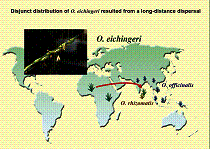Nucleotide variation in 10 unlinked nuclear genes was investigated in species-wide samples of the C-genome Oryza species as well as O. sativa and its wild progenitors. The results indicated 1) three C-genome species harbored low levels of nucleotide variation relative to other plant species partly because of their smaller historic effective population sizes. Two speciation events happened within a short time ( 0.3-0.4 mya) . A long-distance dispersal from West Africa to Sri Lanka results in the disjunct distribution of O. eichingeri (Fig. 1) ( Mol Biol Evol, 2007) ; 2) Comparable levels of nucleotide variation were found between O. rufipogon and O. nivara without significant genetic differentiation between them. Only 20 — 30% of the diversity in wild species was retained in O. sativa , suggesting a severe bottleneck during domestication of rice (Fig. 2) ( Mol Biol Evol, 2007 ) ; 3) Two models have been proposed to reconcile previously conflicting evidence regarding rice domestication ( Curr Opin Genet Dev. 2007 ).

Fig. 1. A long-distance dispersal from West Africa to Sri Lanka results in the disjunct distribution of O ryza eichingeri .

Fig. 2. Comparisons of nucleotide polymorphism of main crops, indicating s everity of bottleneck in rice domestication .
